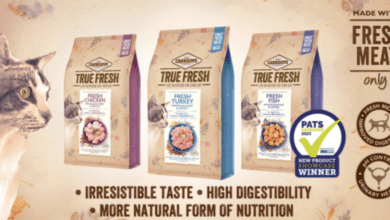The growing problem of obesity in dogs

Obesity is a growing problem in dogs. However, the 2019 Burns Pet Nutrition Pet Census found that 89% of dog owners think their pet’s weight is normal. In 2018 the PFMA (Pet Food Manufactures Association) surveyed Veterinary Professionals at the London Vet Show and found that 74% believed that obesity had increased over the last five years and 51% of dogs that vets saw were overweight or obese.
All vets surveyed were concerned about the prevalence of obesity, but it seems that pet owners may not be as concerned. It is important that the pet industry continues to educate owners in what a healthy weight looks like and help them with their pet’s weight loss journey.
What causes obesity?
Obesity is generally caused by the dog eating too much food or eating food that is too high in calories compared to the amount of energy they are burning from their daily activities.
The dog’s feeding amounts will be important, but working on the Nutrition Helpline at Burns Pet Nutrition we often speak to owners who forget to consider the treats they are giving their dogs. These are often high in calories and leftovers, as well as dental chews, are some of the worst culprits.
Neutering is a risk factor as it slows down a dog’s metabolic rate, so they aren’t burning as many calories as they previously did. This does not mean that a dog shouldn’t be neutered but you may need to reassess the diet of a dog after neutering. Some medication can also make dogs more prone to gaining weight so this should be discussed with the vet.
Genetics can also play a role and some dogs are more prone to being overweight. For example, a study found that one in four Labrador Retrievers have a gene mutation that is related to appetite and bodyweight leading them to weigh 1.9kg more than average. However, this does not mean that they are destined to be this way and with a carefully controlled diet most dogs can be an ideal weight.
How to tell if a dog is overweight?
Many owners find it hard to tell if their dog is overweight. Fat dogs have now become the “norm” and people are often more concerned if they see a lean dog. The 2019 Burns Pet Nutrition Census found that 72% of dog owners under the age of 44 say that being able to see their dog’s ribs would be a cause for concern.
This is despite the fact the ribs, hips and the spine should all be able to be easily felt in a dog that’s an ideal weight, and being able to see the last couple of ribs when the dog is moving is also indicative of a perfect weight. This is a concern to experts like John Burns as it highlights that many owners are likely to worry more about seeing their dog’s ribs than their dog gaining weight, even though there are many more health problems associated with dogs being overweight rather than being lean.
Unfortunately, there is a lack of criteria to class dogs as obese. Overweight dogs are often considered over 15% of their usual weight while obese dogs may weigh over 30%.
Body condition scoring a dog is subjective but can help to give the owner an idea of what an ideal dog should look like. Some important areas to assess are the dog’s neck, rib coverage, waistline and back end. Obese dogs tend to have no waistline, but instead may have fat rolls around the neck and a drooping belly.
Their ribs cannot be felt, and they may be the same width from shoulder to hip (without a defined waistline). If you must press to feel the ribs, this means that there is a layer of fat covering them and your dog may be overweight. Dogs who are an ideal weight have a visible waist and you can easily feel their ribs.
Breaking the news to the owner
Some people in the pet industry may feel reluctant to raise the subject because it may be embarrassing or upsetting for the owner as their dog is often an especially important part of their life. Suggesting the dog is carrying a little more weight than they need to be is a good place to start. It is important that they understand that their dog will be much happier and healthier if they lose the weight.
Reassure them that it is possible to get the excess weight off their dog and there are many people that can help with this such as their vet, pet shop and nutritional helplines such as our own.
How to help a dog to lose weight
Dietary management is going to be especially important and may differ from dog to dog. Putting the dog in a calorie deficit is important to burn off their excess fat as they use this as their energy source, therefore, a low-calorie diet would normally be advised. If the dog has not been to the vet for a recent check-up, we would recommend doing so. It is always helpful to work alongside the vet as they can monitor their health, body condition and weight.
We recommend using a diet that is low in calories but high in fibre, often containing wholegrains, which will help to keep the dog feeling fuller for longer such as our Weight Control Chicken & Oats. This allows us to gradually cut the feeding amounts back without the dog feeling too hungry.
The 2019 Burns Pet Nutrition Census found that one in 10 dog owners admit to feeding their dogs more than the recommended feeding guidelines and a total of 47% of respondents confessed to ignoring guidelines completely.
For overweight dogs, the feeding amounts will be particularly important, and we need to feed for the dog’s ideal weight rather than their current weight. We recommend weighing the food out, as this is much more accurate than using a measuring cup or feeding by-eye, which often results in giving the dog too much food.
Many pet treats are high in fat and protein (that’s what makes them tasty) but it is possible to find low fat treats. The PFMA survey found that 98% of vets believed feeding too many treats contributed to most of the issues with overweight pets. Treats should be limited or if given, they should be low in fat such as our Kelties or Weight Control treats and accounted for within the dogs daily feeding amounts. An ideal treat would be raw carrot or other vegetables.
Increasing the amount of physical activity will also help with weight loss. If a dog is very overweight this may be difficult, especially with associated conditions such as arthritis. However, if you gradually increase the amount of exercise each day and work alongside a vet you should be able to improve the fitness level of your dog. Vets may also refer dogs to see physiotherapists, and hydrotherapy can be greatly beneficial for overweight dogs.
Long term management
Once they start to reach their target, the dog’s weight loss should start to slow down as we have already been feeding them for this weight. Many people think they can now increase the food as the dog is no longer on a “diet”. However, this will likely result in the dog gaining the weight again. We need to continue feeding them for their ideal weight in the long term and not just while they are losing the weight.
John Burns, Burns Pet Nutrition, said: “A weight control diet has to be sustainable; losing weight on a strict programme which is then discontinued will not be successful long-term. We need to feed in a way which can be considered as normal for long-term use and wholegrains can do that.”
One of the most difficult times for pet owners may be once the dog has reached their ideal weight as they tend to go back to their old habits. It is our responsibility as pet food manufacturers, pet shops, vets and other pet industry professionals to help them with this and to encourage them to keep up the new, good habits they have learnt.
By Laura Crotch-Harvey, Nutrition Manager at Burns Pet Nutrition













